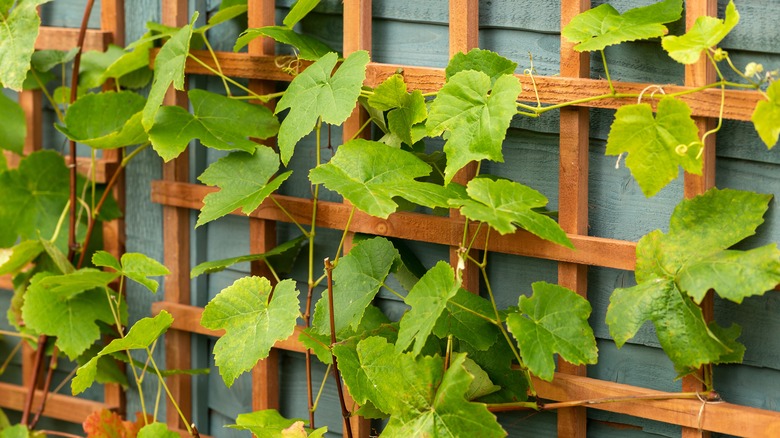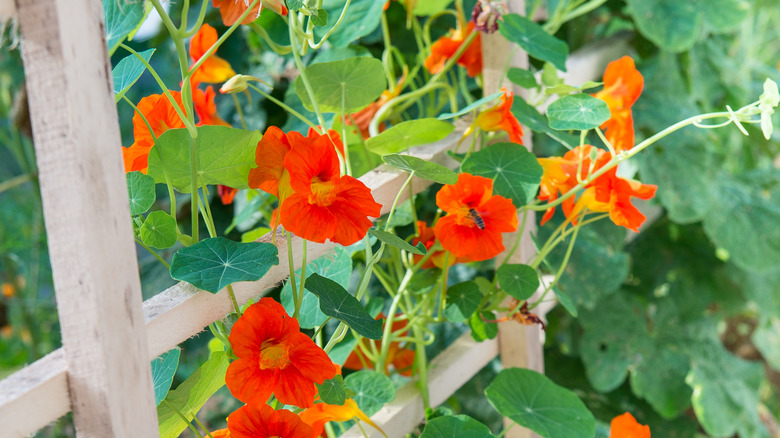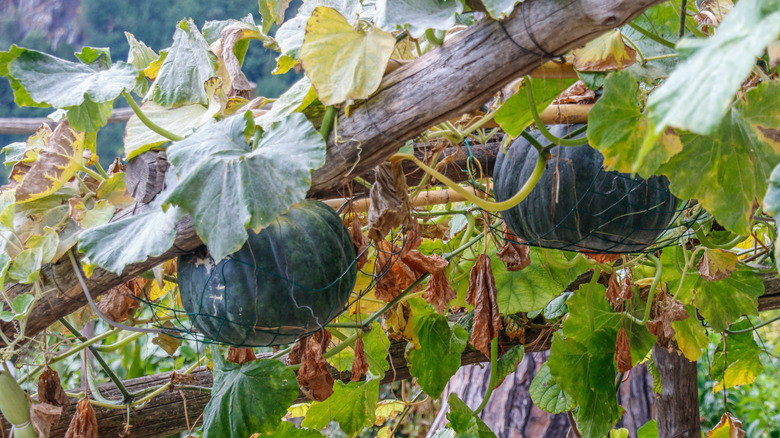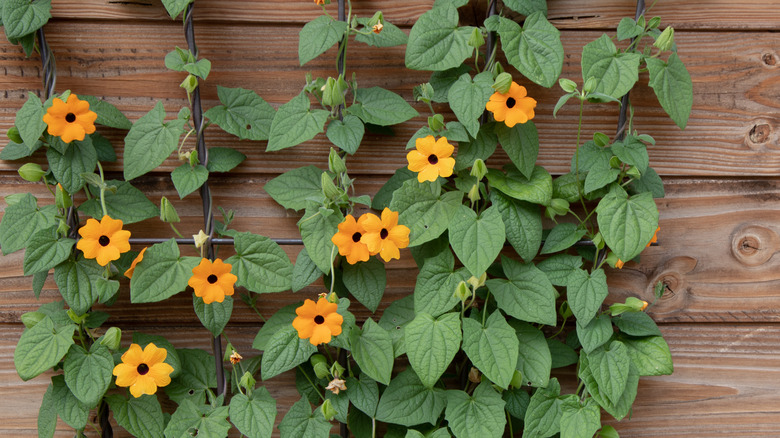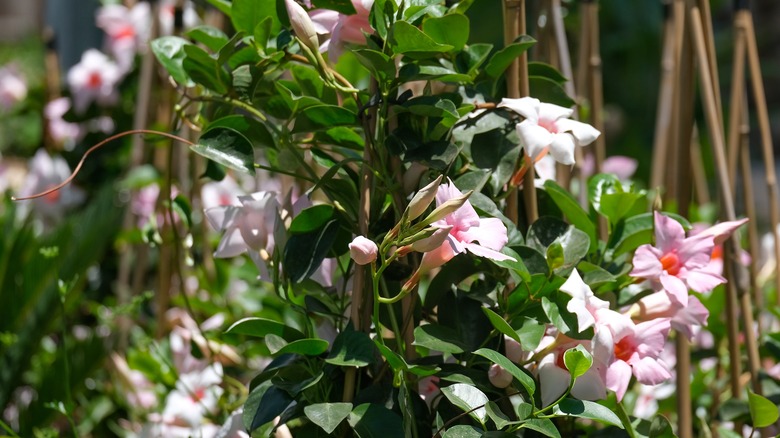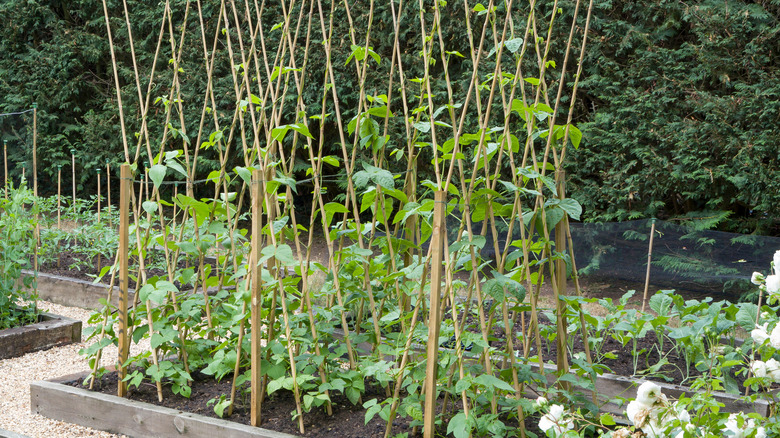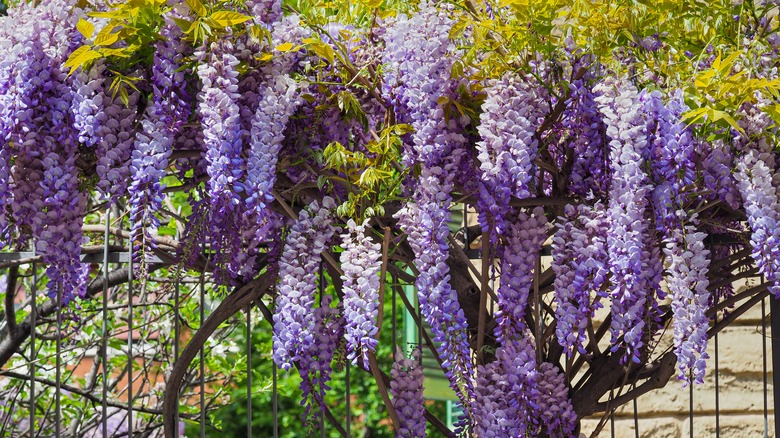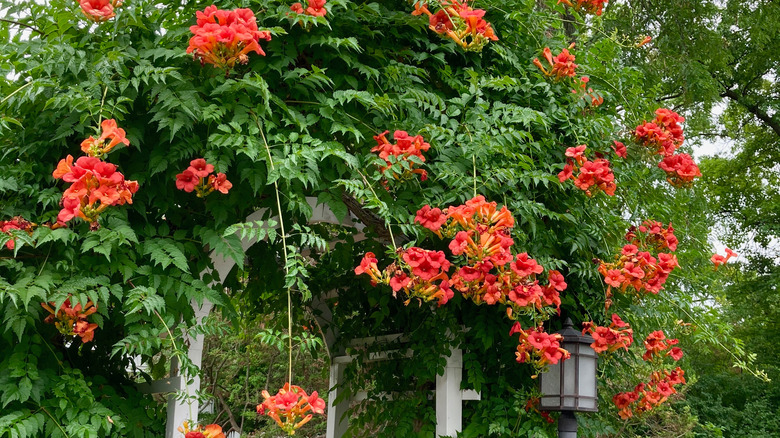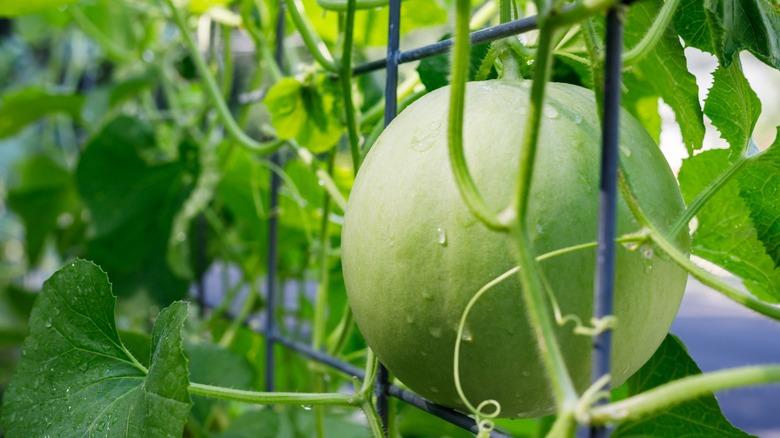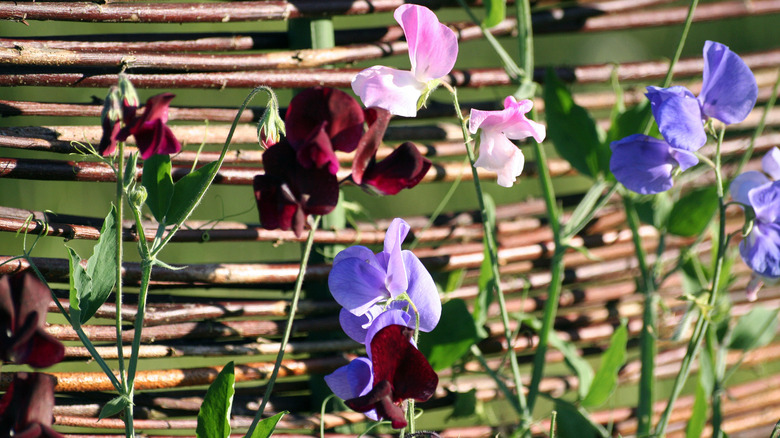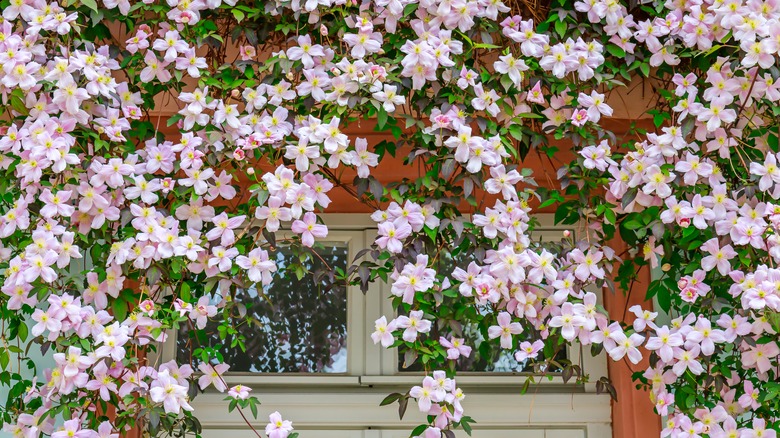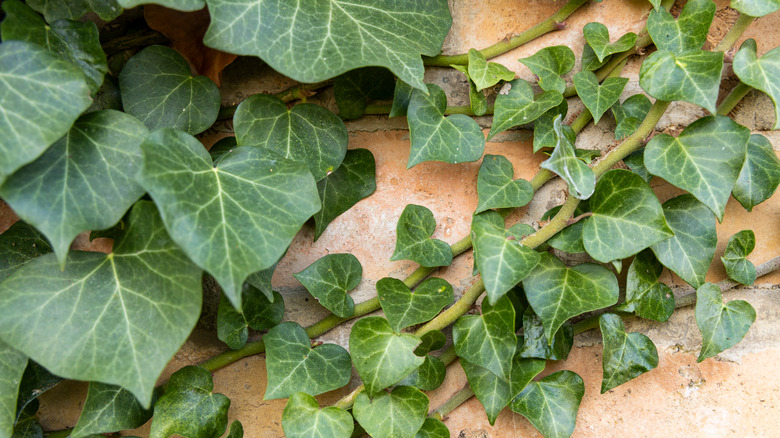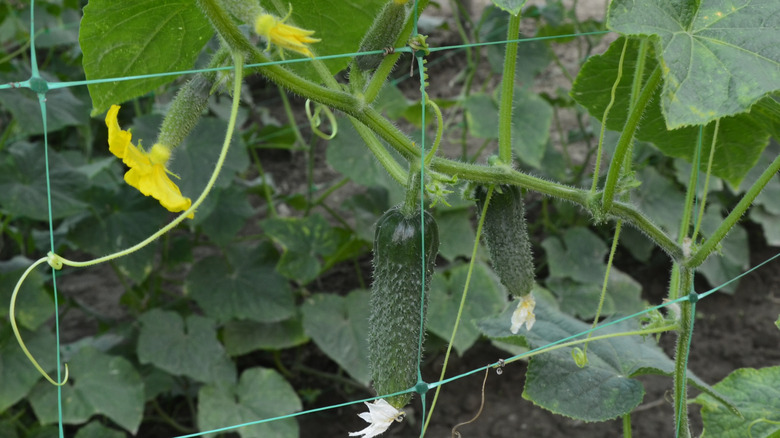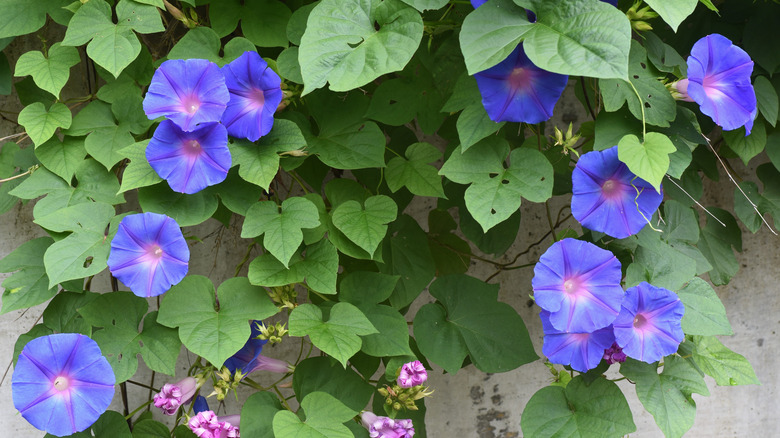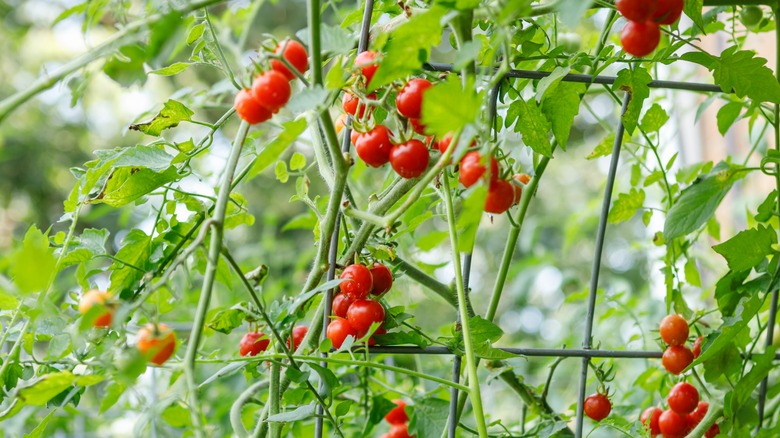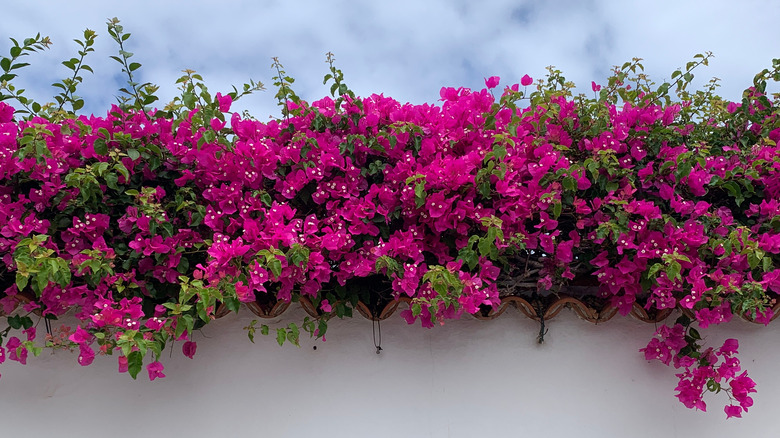15 Plants Perfect For Using With A Trellis
There's no rule that says all your plants have to be grown in pots or in the ground. Actually, some plants do best when they have a little support to grow upwards. Vertical gardening uses support structures for a plant to grow on. Trellises are best for plants that vine, climb, and creep. You can add a vertical garden with a trellis to any backyard space. Wall trellises are great for smaller areas to save on floor space. But you can also have large structures like pergolas and arbors if your backyard has the room.
Using a trellis can actually be healthier for plants by allowing for air circulation since leaves aren't sitting on top of each other, says Rita's Roots Backyard Harvest. More air prevents disease growth, and your plants will also have the benefit of more sunlight and slowing the rotting of ripe fruits and vegetables. Trellises also make harvesting easier since you won't have to bend down or sit on the ground to pick fruits and vegetables. But not every plant prefers growing on a trellis. It's important to choose the right flowers and vegetables for your trellis so that they will thrive.
Jewel of Africa nasturtium
Jewel of Africa nasturtium (tropaeolum majus) climbing flowers bear bright red, orange, yellow, and cream shades that bloom in the summer and fall. Because of their large, showy blooms and variegated foliage, this nasturtium is great in a featured place in your garden, like growing up the side of a house. They do well both in the ground and in pots.
Grown best in USDA Zones 9 through 11, the Jewel of Africa Nasturtium prefers well-draining soil that stays moist. It thrives in full sun to partial shade, says Park Seed. The plant can grow up to 10 feet tall.
Pumpkins
It may seem like there is no way a pumpkin (cucurbita) can grow vertically. But with a sturdy trellis, pumpkins up to 25 pounds can grow vertically without issue. The best pumpkins to grow vertically are Jack be little, hooligan, and baby boo pumpkins, says Urban Garden Gal. It's best to wait until after the last frost when the soil has thawed to plant pumpkins.
Pumpkins will thrive in USDA Zones 3 through 7. Plant the pumpkin seeds in warm, fertile soil. The seeds and mature plants will need ample water, especially as fruits and flowers begin to form.
Black-eyed Susan vine
You'll often see black-eyed Susan vines (Thunbergia alata) growing on the side of the road during the summertime. But you can also grow bundles of these bright blooms right in your own backyard. Black-eyed Susan vines grow best on a support structure like a trellis rather than along the ground, according to the University of Wisconsin-Madison.
A black-eyed Susan vine requires nutrient-rich, moist soil to thrive. The plant loves full sun and will flower brightly in the summer. They can live outside in USDA Zones 10 and 11 year-round, growing to a maximum height of about 8 feet.
Mandevilla
Bearing bright red and pink blooms, mandevillas are annuals that can act as ground cover or vining plants. Mandevillas are great flowers to have grow up a pergola because their lush foliage and bright booms will provide extra shade and grow as they grow up to 15 feet tall.
Ohio Tropics reports that these flowers are sun-loving plants that require at least half a day of full, direct sunlight — more sun will lead to larger, brighter blooms. Water thoroughly after the top inch of soil is dry. Mandevillas thrive in USDA Zones 9 to 11 in a standard potting mix with good drainage.
Pole beans
If you have a vegetable garden, then pole beans (Phaseolus vulgaris) are an excellent addition. They're easy to grow and do well even when you have little space to dedicate to them. The easy-going nature makes pole beans an ideal choice for trellis gardens.
Pole beans can grow as tall as 15 feet high, according to Almanac. Plant pole beans in well-draining soil with a neutral pH. Be sure to set up supports before planting, as beans don't like disturbed roots. Pole beans can grow in USDA Zones 2 through 11 in full sun.
Wisteria
Magical and vibrant, Wisteria is a favorite among floral lovers. They make great additions to pergolas and arbors but will need a sturdy structure as they can become pretty heavy, according to Swanson Nursery.
Wisteria are incredibly hardy, thriving in USDA Zones 5 to 9. Choose a well-draining soil low in nitrogen but high in phosphorus and potassium to encourage bloom growth. Keep soul moist but not soaking. The flowers will need at least six hours of full sunlight, but partial shade will not harm the plant.
Trumpet creeper vine
Trumpet creeper vines (Campsis radicans) are aggressive and easy growers that produce large, trumpet-shaped blooms. Their quick-growing nature makes them a great option to grow on a trellis, where Gardening with Charlie Nardozzi says the flower can get up to 30 feet.
These flowers don't need a ton of additional care, requiring moderately fertile soil and no additional fertilizer. The plant will thrive in USDA Zones 4 through 9. Trumpet creeper vines like full or partial sun or partial shade and bloom through mid-summer and fall.
Melons
Sweet summer fruits like melons (Cucumis melo) are a great option for vertical gardens. Watermelons (citrullus lanatus), cantaloupe (cucumis melo var. cantalupensis), and honeydew (cucumis melo L.) are all ideal for trellising.
Plant melons in the spring and harvest in the mid-summer in USDA Zones 2 to 11. These plants need full sunlight to thrive, so plant them where they can receive at least eight hours of uninterrupted sunlight, says Abundant Mini Gardens. Vines can grow up to 18 inches tall and need well-draining soil with a pH between 6.0 and 6.5.
Sweet pea
Enchanting, fragrant flowers, sweet peas (lathyrus) are pretty additions to gardens. There are annual and perennial varieties. The annual variety is the better choice for gardens as perennial sweet peas are an invasive species, says Empress of Dirt.
Annual vines can grow up to six feet tall when given partial bright light, like the morning sun, and planted in well-draining, compost-rich soil. Sweet peas grow best in USDA Zones 4 to 8. Sow seeds in the early spring for blooms in the late spring through summer.
Clematis
Clematis are spectacular flowering vines that gardeners love because of the variety of colors and flower forms. Some varieties are perennials and some are evergreen, but most clematis are deciduous.
Varieties differ in size, with some growing as tall as 30 feet while others as small as 5 feet, according to Clemson Cooperative Extension Home & Garden Information Center. They are strong growers, and varieties can bloom anywhere between February to November, depending on species and location. Typically USDA Zones 4 to 9 are best. Fertile, well-draining soil with full sun for at least six hours a day will help produce showy blooms.
Ivy
Famous for vining, ivy (hedera) species are an obvious but still stunning choice for a garden trellis. English, Algeria, Japanese, and Persian ivies are all popular varieties for outdoor gardens.
Fast-growing and easy-going ivy varieties thrive in well-draining but moist soil and bright indirect light, according to Backyard Boss. Plant these vines in USDA Zones 4 through 13 in either the spring or fall. Between September and October, ivy can produce small, green-white flowers, but the leaves are often evergreen perennials.
Cucumbers
Trailing cucumbers (cucumis sativus) are ideal because they're natural climbers. Adding a trellis for your cucumbers to climb can increase crop production and make harvesting much easier for gardeners.
Plant cucumbers in well-draining soil, preferably a loose, sandy loam in USDA Zones 4 to 12 for the best results. Allow cucumbers to get full sun, so avoid shady areas under trees, which can also rob cucumbers of nutrients, says Texas A & M AgriLife Extension. Vines can grow as large as 8 feet tall or even taller. Harvest plants during the summer months.
Morning glory
Morning glories (Ipomoea) are a classic flower that gardeners love because they can quickly take over a trellis, pergola, or arbor. These bright, trumpet-shaped blooms open in the morning and close in the late afternoon.
Plant morning glories in USDA Zones 3 to 10, where they can thrive in warmer, tropical climates. Garden Design says morning glories planted in moderately fertile, well-draining soil and, when facing full sun, they can reach heights of up to 12 feet and produce brightly-colored blooms between June and October.
Tomatoes
Growing large tomatoes (solanum lycoperscium L.) is the goal for many gardeners, and a trellis can help make that happen. Trellises offer support to tomato plants that help prevent the stems from breaking in the wind, says Hoss Tools.
Plant tomatoes in well-draining and fertile soil, preferably in areas where plants from the same family like potatoes or peppers haven't been planted, advises Grow Veg. Tomatoes can grow up to 4 feet tall in any USDA Zone as long as the plant receives full sun for at least eight hours every day. Harvest the fruit in July and August.
Bougainvillea
Loved for the lush blooms and foliage, bougainvillea doesn't need a lot of care to thrive and take over a trellis or structure. They're quick growers and can reach heights of almost 20 feet, says Get Busy Gardening.
These flowers prefer warmer climates found in USDA Zones 9 through 11. Outside these areas, the foliage and branches can die after a freeze. Provide these flowers with well-draining soil and full sun to allow the blooms to grow large and colorful. This perennial regrows every spring, blooming from May through December.
